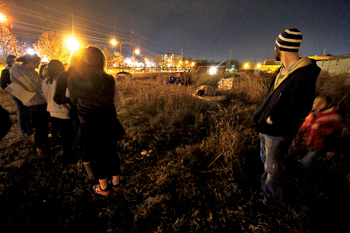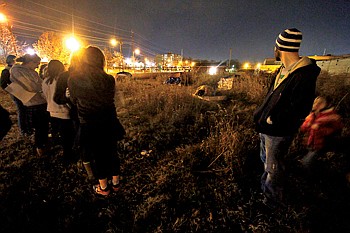 Staff Photo by Jake Daniels/Chattanooga Times Free Press
Tour members look at a group of homeless shelters between 10th and 11th streets on Thursday night. Changers, an anti-poverty group, led groups of volunteers and members of the Chattanooga City Council on a walking tour of local homeless abodes, calling it "Home(less) for the Holidays."
Staff Photo by Jake Daniels/Chattanooga Times Free Press
Tour members look at a group of homeless shelters between 10th and 11th streets on Thursday night. Changers, an anti-poverty group, led groups of volunteers and members of the Chattanooga City Council on a walking tour of local homeless abodes, calling it "Home(less) for the Holidays."In a field behind the Community Kitchen, CC Veazey stared at several makeshift blanket tents.
There was movement inside each of them and within one, someone was coughing - hard. None of the tent occupants volunteered to peep out to see why a group of strangers stood around.
"Standing there looking at those tents in my own backyard brought it home with an exclamation point that there is homelessness here - not just in the world but in my backyard [Chattanooga]," Veazey said, recalling the scene later.
"I turned away to regroup and there were more people sleeping on a [warehouse] side dock.
Members of a local anti-poverty and human rights group called Changers hoped their "Home(less) Tour of Homes" would bring about just that reaction. Changers on Thursday took about 40 business people, students, and ordinary families through the world of homelessness in Chattanooga.
"Where do we go from here?" Changers member Landon Howard asked the group after they had visited the St. Matthew's Shelter for Men, talked with a young homeless woman who sleeps under a parking lot structure on Broad Street, and met a formerly homeless mom and her two young sons.
"You can't say you don't know anymore," Howard told them.
Veazey, a hospice chaplain, already had made up her mind about what she would do Christmas Day. She will spend it at the Community Kitchen volunteering, she said.
David Cook, a Changers member, said the group decided to use the tour to enlist help in putting pressure on Chattanooga leaders.
"We want to see something real happen in the way of a shelter in the Farmer's Market area. We invited the City Council," Cook said.
Only Councilman André McGary came.
"I wanted to show my support," he said.
In the Chattanooga area, about 4,000 people a year experience homelessness, and about 1,000 are children, according to The Blueprint to End Chronic Homelessness in the Chattanooga Region in Ten Years, a study conducted by the city several years ago.
About 670 are chronically homeless, the report states.
Ron Fender, a Gregorian monk and the outreach coordinator for Community Kitchen, said Thursday the numbers have risen.
"I say by 2,000," he said of the annual 4,000. "Remember that Blueprint was pre-recession."
Mary Ellen Galloway, executive director for Interfaith Homeless Network, which coordinates shelter services for families with a coalition of about 50 churches, thought the 4,000 may have doubled.
The blueprint recommends the construction of 1,400 units of permanent housing for the homeless by 2014. The Chattanooga region already spends $7.3 million annually for emergency and transitional services, shelter and housing for homeless people, the report states.
Littlefield agreed earlier Thursday that the city still needs a better way to help the homeless.
"We desperately need an emergency shelter. We actually lost ground in terms of emergency shelters," he said. "Right now we're having to depend on the Community Kitchen, and we helped them buy some improved pads so people can sleep on the floor in there in times of inclement weather like now. But that's not acceptable."
* 4,000 - People in the Chattanooga area who experience homelessness in a year.* 1,000 - Homeless children included among the 4,000.* 670 - People who are chronically homeless.* 1,400 - Units of permanent housing recommended to be built for the homeless by 2014.* $7.3 million - Annual amount the Chattanooga area spends on emergency and transitional services, shelter and housing for homeless people.Source: "The Blueprint to End Chronic Homelessness in the Chattanooga Region in Ten Years"
Fender said the Community Kitchen averaged about 89 people over four recent cold nights.
"We can't do that every night," Fender said. "We don't have the resources."
Littlefield in his first campaign for mayor ran on a platform that included finding new and more-efficient ways to house the homeless. He proposed a central location for a shelter and for the city's homeless services.
It hasn't been built, but the mayor thinks the city has made progress.
"I think we have better circumstances in place for counseling and helping get people in permanent housing, but we need a shelter for emergency, short-term needs," he said, noting that Union Gospel Mission has moved out of the central city to the foot of Signal Mountain, and the Rescue Mission is now in the old Senter School on Holtzclaw Avenue.
Neither are emergency shelters, the mayor added.
At St. Matthew's shelter, the group met a man who said he let drinking and the falling real estate market bring him to bottom.
At the Family Housing and Learning Center, they met Misty Hammonds and her sons, Malachi, 5, and Justin, 2. After six months in a transitional apartment next door to the Community Kitchen, Hammonds was able to get her own apartment earlier this month.
On the street, they met 34-year-old Angela Solomon, who said she has been homeless off and on since she was a teen.
"I have a mental illness," Solomon told them, after pointing out where she sleeps beneath a parking lot. She recited for them a poem she wrote recently about keeping a positive outlook.
"Don't be afraid of the homeless," she told the tour group. "We're just like you, just down on our luck."
